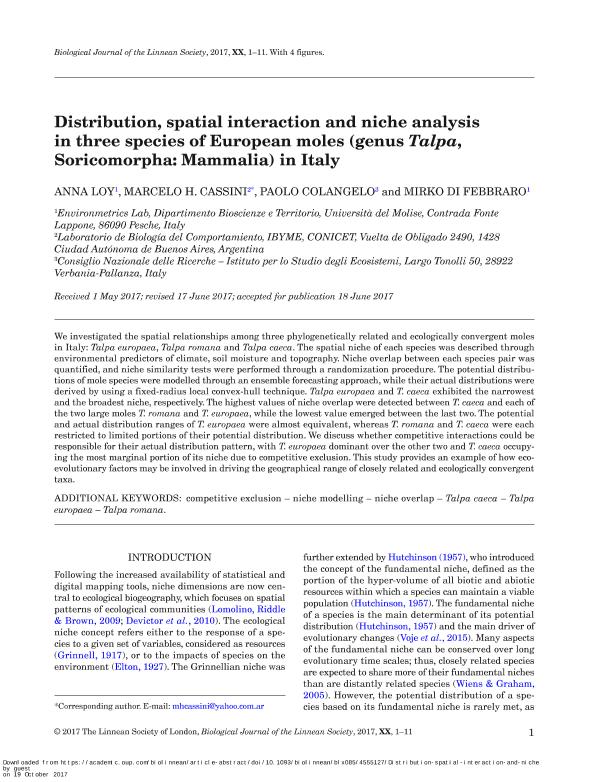Mostrar el registro sencillo del ítem
dc.contributor.author
Loy, Anna
dc.contributor.author
Cassini, Marcelo Hernan

dc.contributor.author
Colangelo, Paolo
dc.contributor.author
Di Febbraro, Mirko
dc.date.available
2018-11-05T22:48:22Z
dc.date.issued
2017-12
dc.identifier.citation
Loy, Anna; Cassini, Marcelo Hernan; Colangelo, Paolo; Di Febbraro, Mirko; Distribution, spatial interaction and niche analysis in three species of European moles (genus Talpa, Soricomorpha: Mammalia) in Italy; Wiley Blackwell Publishing, Inc; Biological Journal of The Linnean Society; 122; 4; 12-2017; 1-11
dc.identifier.issn
0024-4066
dc.identifier.uri
http://hdl.handle.net/11336/63720
dc.description.abstract
We investigated the spatial relationships among three phylogenetically related and ecologically convergent moles in Italy: Talpa europaea, Talpa romana and Talpa caeca. The spatial niche of each species was described through environmental predictors of climate, soil moisture and topography. Niche overlap between each species pair was quantified, and niche similarity tests were performed through a randomization procedure. The potential distributions of mole species were modelled through an ensemble forecasting approach, while their actual distributions were derived by using a fixed-radius local convex-hull technique. Talpa europaea and T. caeca exhibited the narrowest and the broadest niche, respectively. The highest values of niche overlap were detected between T. caeca and each of the two large moles T. romana and T. europaea, while the lowest value emerged between the last two. The potential and actual distribution ranges of T. europaea were almost equivalent, whereas T. romana and T. caeca were each restricted to limited portions of their potential distribution. We discuss whether competitive interactions could be responsible for their actual distribution pattern, with T. europaea dominant over the other two and T. caeca occupying the most marginal portion of its niche due to competitive exclusion. This study provides an example of how ecoevolutionary factors may be involved in driving the geographical range of closely related and ecologically convergent taxa.
dc.format
application/pdf
dc.language.iso
eng
dc.publisher
Wiley Blackwell Publishing, Inc

dc.rights
info:eu-repo/semantics/openAccess
dc.rights.uri
https://creativecommons.org/licenses/by-nc-sa/2.5/ar/
dc.subject
Competitive Exclusion
dc.subject
Niche Modelling
dc.subject
Niche Overlap
dc.subject
Talpa Caeca
dc.subject
Talpa Europaea
dc.subject
Talpa Romana
dc.subject.classification
Ecología

dc.subject.classification
Ciencias Biológicas

dc.subject.classification
CIENCIAS NATURALES Y EXACTAS

dc.title
Distribution, spatial interaction and niche analysis in three species of European moles (genus Talpa, Soricomorpha: Mammalia) in Italy
dc.type
info:eu-repo/semantics/article
dc.type
info:ar-repo/semantics/artículo
dc.type
info:eu-repo/semantics/publishedVersion
dc.date.updated
2018-10-23T15:53:55Z
dc.journal.volume
122
dc.journal.number
4
dc.journal.pagination
1-11
dc.journal.pais
Reino Unido

dc.journal.ciudad
Londres
dc.description.fil
Fil: Loy, Anna. Universita degli Studi del Molise; Italia
dc.description.fil
Fil: Cassini, Marcelo Hernan. Consejo Nacional de Investigaciones Científicas y Técnicas. Instituto de Biología y Medicina Experimental. Fundación de Instituto de Biología y Medicina Experimental. Instituto de Biología y Medicina Experimental; Argentina
dc.description.fil
Fil: Colangelo, Paolo. Consiglio Nazionale delle Ricerche; Italia
dc.description.fil
Fil: Di Febbraro, Mirko. Universita degli Studi del Molise; Italia
dc.journal.title
Biological Journal of The Linnean Society

dc.relation.alternativeid
info:eu-repo/semantics/altIdentifier/doi/http://dx.doi.org/10.1093/biolinnean/blx085
dc.relation.alternativeid
info:eu-repo/semantics/altIdentifier/url/https://academic.oup.com/biolinnean/article-abstract/122/4/872/4555127
Archivos asociados
